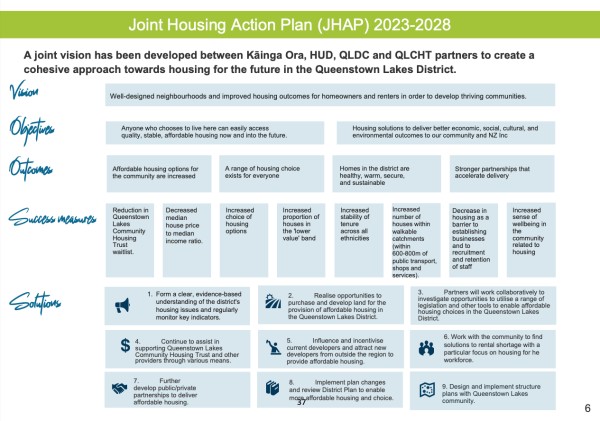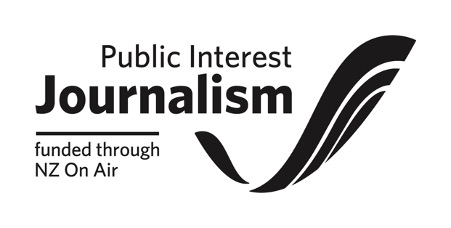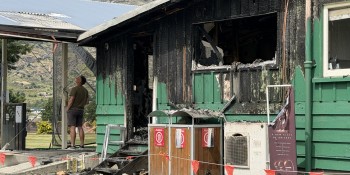QLDC's housing plan revealed: but will it make any difference?

The Queenstown Lakes District Council has unveiled its plan for improving housing affordability in the district, but there's little evidence of pragmatic shorter-term solutions in the 20-page document.
Speaking with Crux this week, QLDC Mayor Glyn Lewers acknowledged there's no silver bullet to the district's housing crisis but "at some point the action's got to happen".
His follow-up question: "How do we initiate that?".
Some of the answer sits within the draft action plan made public today, ready for consideration by councillors next week.
Council staff have spent eight months working on the Joint Housing Action Plan, or the JHAP for short, with other stakeholders in on the discussion.
Its scene-setting front pages paint a bleak picture of housing pressures in the district.
It says there are 860 households are on the Queenstown Lakes Community Housing Trust wait list, while 86 percent of respondents to a recent council survey listed housing affordability as a barrier to remaining in the district.
Meanwhile, the average house price in the district is currently just under $1.7m, 75 percent more than the New Zealand average, and median rent is $700 a week compared to $560 nationally.
The draft JHAP lists several objectives – the first, particularly audacious: that “anyone who chooses to live here can access quality, stable, affordable housing now and into the future”.
So, how does it plan to achieve that? Well, there’s a list of nine possible solutions.

There's few low-hanging fruit, but the Joint Housing Action Plan sets out a roadmap to providing more affordable housing across the district.
Some of the proposed solutions focus on building our way out of the problem, others on tweaking or introducing regulations and policies to give affordable housing and those who need it a fighting chance.
Unfortunately, for those in desperate situations right now, with winter approaching, none are particularly low-hanging fruit, and rely on multiple stakeholders playing a part.
One proposed solution: Realising opportunities to purchase and develop land for the provision of affordable housing in the Queenstown Lakes District.
The plan suggests this could be in partnership with the local housing trust, Kainga Ora, or a new joint venture company. Another option is for council to purchase land or utilise land it already owns for affordable housing development by a registered community housing provider, the plan says.
The Lakeview land comes to mind - QLDC by-election candidate John Glover this week challenged earlier Lakeview decision making, saying the council was focused on “towers for tourists” rather than acting in the best interests of residents and ratepayers.
The plan also proposes public-private partnerships to deliver more types of houses at more affordable price points as well as housing targeted at specific workers. The plan suggests investigating ways to “incentivise developers to deliver affordable housing through financial and planning incentives”, including those already successfully being used.
There's actions aimed at dealing with the current rental crisis, which is making it harder for local businesses to recruit and retain workers, including upping community education around the “impacts of short-term letting” and embracing an “adopt a worker” scheme.
One perhaps more easily achievable solution involves ensuring decision makers have an “evidence-based understanding” of the district’s housing issues.
“Limited deprivation data and communication on how many people are in need of services within the region has contributed to underinvestment in affordable housing” in the district, the plan says.

'There is a focus that's being driven by the community because they want to see something done - it just takes longer than what is expected': Mayor Gyn Lewers.
Giving it teeth, the draft plan includes KPIs, measurable outcomes to determine what impact the proposed solutions are having year-on-year, and baseline measures have been established for a number of indicators, including increases in housing within walking distance of public transport, shops and services, and numbers on the housing trust's wait list.
The plan has been developed between the Grow Well Whaiora partners - local, regional, and central government, plus iwi – that are working collaboratively to figure out how Queenstown can best handle urban growth.
Mayor Lewers says change initiated by government, whether it be local or central, "does take time".
But he says when it comes to the current housing crisis, the needs of the community are "driving the focus".
In recent weeks, Queenstown's working homeless have protested as they resort to living in vehicles and between couches as rentals remain scarce, while social service providers relay the increasing pressure they see their clients under.
"If there was a problem and we were all passive about it, I don't think there would be an impetus for all of us to work together.
"There is a focus that's being driven by the community because they want to see something done - it just takes longer than what is expected."
Next week the draft plan will be presented to councillors for sign off for public consultation.
It is proposed community comment be sought over a five-week period starting May 1.
The feedback collected will be summarised and used to further develop the JHAP.


























